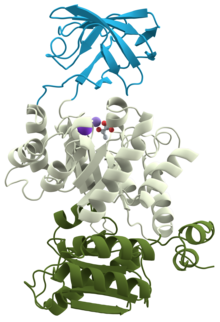
Back بيروفات كايناز Arabic Piruvat cinasa Catalan Pyruvatkinase German Piruvato cinasa Spanish پیرووات کیناز Persian Pyruvaattikinaasi Finnish Pyruvate kinase French Piruvato quinase Galician Piruvato chinasi Italian ピルビン酸キナーゼ Japanese
| Pyruvate kinase | |||||||||
|---|---|---|---|---|---|---|---|---|---|
 3D structure of pyruvate kinase (1PKN) | |||||||||
| Identifiers | |||||||||
| EC no. | 2.7.1.40 | ||||||||
| CAS no. | 9001-59-6 | ||||||||
| Databases | |||||||||
| IntEnz | IntEnz view | ||||||||
| BRENDA | BRENDA entry | ||||||||
| ExPASy | NiceZyme view | ||||||||
| KEGG | KEGG entry | ||||||||
| MetaCyc | metabolic pathway | ||||||||
| PRIAM | profile | ||||||||
| PDB structures | RCSB PDB PDBe PDBsum | ||||||||
| Gene Ontology | AmiGO / QuickGO | ||||||||
| |||||||||
Pyruvate kinase is the enzyme involved in the last step of glycolysis. It catalyzes the transfer of a phosphate group from phosphoenolpyruvate (PEP) to adenosine diphosphate (ADP), yielding one molecule of pyruvate and one molecule of ATP.[1] Pyruvate kinase was inappropriately named (inconsistently with a conventional kinase) before it was recognized that it did not directly catalyze phosphorylation of pyruvate, which does not occur under physiological conditions.[2] Pyruvate kinase is present in four distinct, tissue-specific isozymes in animals, each consisting of particular kinetic properties necessary to accommodate the variations in metabolic requirements of diverse tissues.
- ^ Gupta V, Bamezai RN (November 2010). "Human pyruvate kinase M2: a multifunctional protein". Protein Science. 19 (11): 2031–44. doi:10.1002/pro.505. PMC 3005776. PMID 20857498.
- ^ Goodman HM (2009). Basic Medical Endocrinology (4th ed.). Elsevier. p. 132. ISBN 978-0-12-373975-9.